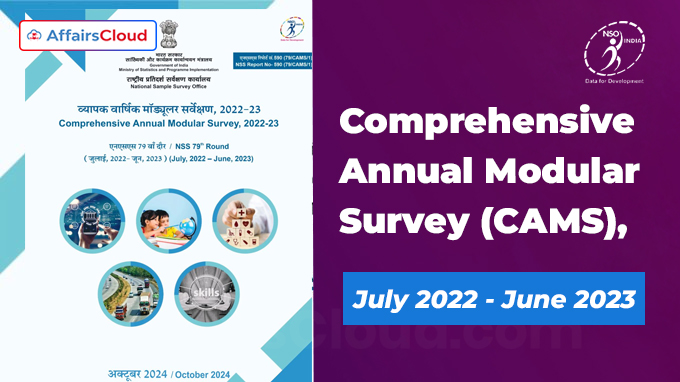 The Ministry of Statistics and Programme Implementation (MoSPI) released the ‘Comprehensive Annual Modular Survey (CAMS) : July 2022- June 2023’. This survey was conducted as part of the 79th round of the National Sample Survey (NSS), conducted from July 2022 to June 2023. The survey is not conducted in some of the villages in Andaman and Nicobar Islands.
The Ministry of Statistics and Programme Implementation (MoSPI) released the ‘Comprehensive Annual Modular Survey (CAMS) : July 2022- June 2023’. This survey was conducted as part of the 79th round of the National Sample Survey (NSS), conducted from July 2022 to June 2023. The survey is not conducted in some of the villages in Andaman and Nicobar Islands.
- The main purpose of CAMS was to collect data to create indicators on important areas like education, medical expenses paid directly by people, mobile and internet use, access to financial services, Information and Communication Technology (ICT) skills, and ownership of assets.
About Comprehensive Annual Modular Survey (CAMS) :
i.The CAMS, a yearly survey, is introduced and designed to collect information required to generate some important Socio-Economic indicators that are not available from any other source.
ii.It is conducted by the National Sample Survey Office (NSSO) under the Ministry of Statistics and Program Implementation (MoSPI).
iii.This survey provided the information which was required for the purpose of monitoring the performances of Sustainable Development Goals (SDGs) indicators.
- It also gathered information on basic services such as drinking water, sanitation, energy use, birth registration, and transportation access.
iv.This survey also attempted to collect person-level information on the formal education of erstwhile household members aged 18 years or above who are currently studying outside India.
Sampling Method:
The survey used a Two-Stage Stratified Sampling method:
i.First Stage Units (FSUs): In rural areas, the FSUs were villages or smaller sub-units, while in urban areas, they were blocks from the Urban Frame Survey (UFS) or sub-units. These FSUs were distributed across States and Union Territories(UT) based on the population figures from the 2011 Census.
ii.Second Stage Units (SSUs): These were households selected in both rural and urban areas.
iii.For both FSUs and SSUs, a method called Simple Random Sampling Without Replacement (SRSWOR) was used to ensure that each unit had an equal chance of being selected, without repeating any unit.
Key Findings:
i.In rural areas, approximately 96.5% of individuals aged 15-24 years can read and write simple statements in their everyday lives and perform basic arithmetic calculations. In urban areas, this figure is around 97.9%.
- For individuals aged 15-29 years, the percentages are 95.3% in rural areas and 97.4% in urban areas, with an overall figure of 95.9%.
- For those aged 15 years and above, the percentages are 77.3% in rural areas, 90% in urban areas, and an overall average of 81.2%.
- The average number of years of formal education for people aged 15 and older in India is 8.4 years. For those who are 25 and older, this average drops to 7.5 years.
iii.In terms of medical expenses, households in rural areas spent an average of Rs 4,129 on hospitalization over the past year, while urban households spent Rs 5,290. For non-hospitalized medical treatment in the last 30 days, rural households had an average expense of Rs 539, and urban households spent about Rs 606.
Other key indicators:
i.The survey reveals significant insights into literacy, education, and infrastructure across rural and urban India. Among individuals aged 15-24, literacy rates stand at 96.7% in rural areas and 98.0% in urban areas, resulting in an overall literacy rate of 97.0%. For children, aged enrollment in primary education is 90.5% in rural areas and 89.2% in urban settings. Among those aged 25 and above, 30.4% of rural and 56.6% of urban individuals have completed secondary education.
ii.In terms of youth participation, 45.9% in rural areas and 57.1% in urban areas engaged in education and training within the past year, while 25.0% of rural youth are not in education, employment, or training (NEET).
iii.Financial inclusion is high, with 94.6% of adults having a bank account. Mobile usage is prevalent, with 95.7% of young people able to use mobile phones, and 82.1% can access the internet. The number of borrowers per 100,000 people was 18,714 in rural areas and 17,442 in urban areas.
iv.Digital Skills– Among individuals aged 15-24, 95.7% in rural and 97.0% in urban areas could use a mobile phone. In the same age group, 74.9% in rural and 87.3% in urban areas could send messages with attachments, while only 21.0% in rural and 40.2% in urban areas could perform complex digital tasks like online banking.
v.Additionally, 82.1% in rural and 91.8% in urban areas had internet access. Remarkably, 99.5% in rural areas and 99.8% in urban areas were covered by 4G or higher mobile technology.
vi.Household Assets and Services– The survey revealed that 94.2% of rural households and 97.1% of urban households possessed a phone, but only 4.2% of rural households had computers. Access to all-weather roads was reported by 94.2% of rural households, while 41.6% of urban residents had access to high-capacity public transport within 1 km.
vii.Health and Infrastructure– 90.5% of children under five in rural areas had registered their birth, and access to improved drinking water sources was 94.9% in rural and 97.5% in urban households. Additionally, 97.1% of rural and 98.9% of urban households had improved latrine facilities.
viii.These findings underscore the existing disparities between rural and urban regions while also highlighting positive trends in literacy, digital access, and basic infrastructure improvements across the country.
About the Ministry of Statistics and Programme Implementation (MoSPI) :
Minister of State (Independent Charge, IC)(MoS) – Rao Inderjit Singh (Constituency- Gurugram ,Haryana)




